History
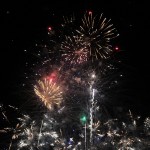 I think that one of the things most people look forward to in mid-summer is Independence Day. Of course, the normal holiday for many people is filled with picnics, fireworks, and celebration of our freedom. Many of us consider the price that was paid in the Revolutionary War to win our freedom from England, and then our thoughts move on to the many wars the United Stares has fought into keep our freedoms, and to win freedom for oppressed nations around the world. It’s a noble thing our soldiers do, often with little thanks from those they help. And all too often, their work is quickly forgotten or even protested by those who do not understand how important it is not to give away our freedoms to those who do not share our values.
I think that one of the things most people look forward to in mid-summer is Independence Day. Of course, the normal holiday for many people is filled with picnics, fireworks, and celebration of our freedom. Many of us consider the price that was paid in the Revolutionary War to win our freedom from England, and then our thoughts move on to the many wars the United Stares has fought into keep our freedoms, and to win freedom for oppressed nations around the world. It’s a noble thing our soldiers do, often with little thanks from those they help. And all too often, their work is quickly forgotten or even protested by those who do not understand how important it is not to give away our freedoms to those who do not share our values.
Whatever a person’s politics are, or even if they don’t participate at all, pretty much  everyone celebrates Independence Day. It is a beloved holiday in this country. It’s a day to celebrate who we are as a nation….the land of the free, and the home of the brave. The fireworks are to remember the rockets that were used in the battle for our independence. The patriot soldiers fought hard against the British, never giving up, even if they lost their lives in the battle. The danger was worth the risk. They could no longer be slaves to the British. They were being taxed without representation, and unmercifully. It was time for the United States to become it’s own nation. I don’t think the British have any inkling that they would lose the Revolutionary War. It was like being beaten by your child. How could that “kid” actually have grown enough to beat them…and yet, the “kid” had not only fought against the “parent” country, but they won. They fought and now we’re free!!
everyone celebrates Independence Day. It is a beloved holiday in this country. It’s a day to celebrate who we are as a nation….the land of the free, and the home of the brave. The fireworks are to remember the rockets that were used in the battle for our independence. The patriot soldiers fought hard against the British, never giving up, even if they lost their lives in the battle. The danger was worth the risk. They could no longer be slaves to the British. They were being taxed without representation, and unmercifully. It was time for the United States to become it’s own nation. I don’t think the British have any inkling that they would lose the Revolutionary War. It was like being beaten by your child. How could that “kid” actually have grown enough to beat them…and yet, the “kid” had not only fought against the “parent” country, but they won. They fought and now we’re free!!

Since they won, we have something wonderful to celebrate on July 4th…our independence. When I think of the alternative, I cringe. It’s not that I hate England, because, in fact, I don’t. I have relatives there, including in the royal family, so I don’t hate England, but we were just different. Our values and ideals were different. We could not peacefully co-exist the way we were, And yet, now that we are two separate nations, we are allies. We had to be equals in order to be allies. We had to have their respect, as a free nation, and we got it. We have been a respected, free nation since that day…July 4, 1776. And that is why we still celebrate our independence. Happy Independence Day everyone!!
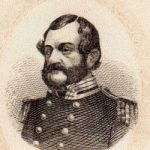 Captain George Hollins joined the United States Navy when he was just 15 years old, and served during the War of 1812. His was a long and distinguished career, but when the Civil War broke out in 1861, he chose to resign his commission, and offer his services to the Confederacy. After a brief stop in his hometown, Baltimore, Hollins offered his services to the Confederacy and received a commission on June 21, 1861. I suppose that every man had to choose a side in the Civil War, and I’m sure he considered his reasons for choosing the Confederacy to be valid, but many of us would consider his actions to be almost traitorous, were it not for the fact that both sides were the United States…just not so united.
Captain George Hollins joined the United States Navy when he was just 15 years old, and served during the War of 1812. His was a long and distinguished career, but when the Civil War broke out in 1861, he chose to resign his commission, and offer his services to the Confederacy. After a brief stop in his hometown, Baltimore, Hollins offered his services to the Confederacy and received a commission on June 21, 1861. I suppose that every man had to choose a side in the Civil War, and I’m sure he considered his reasons for choosing the Confederacy to be valid, but many of us would consider his actions to be almost traitorous, were it not for the fact that both sides were the United States…just not so united.
Hollins devised a plan to capture a commercial vessel that was bringing supplies to the Union Army. Then they planned to use that ship to lure other Union ships into Confederate service. Soon after, Hollins met up with Richard Thomas Zarvona, a fellow Marylander and former student at West Point. Zarvona  was an adventurer who had fought with pirates in China and revolutionaries in Italy. He seemed the perfect co-conspirator for this project. They devised a plan to capture the Saint Nicholas. Then it would be the decoy they used to force other Yankee ships into Confederate service. Zarvona went to Baltimore,where he recruited a band of pirates, who boarded the Saint Nicholas as paying passengers on June 28, 1862. Using the name Madame La Force, Zarvona disguised himself as a flirtatious French woman. Hollins boarded the Saint Nicholas at its first stop.
was an adventurer who had fought with pirates in China and revolutionaries in Italy. He seemed the perfect co-conspirator for this project. They devised a plan to capture the Saint Nicholas. Then it would be the decoy they used to force other Yankee ships into Confederate service. Zarvona went to Baltimore,where he recruited a band of pirates, who boarded the Saint Nicholas as paying passengers on June 28, 1862. Using the name Madame La Force, Zarvona disguised himself as a flirtatious French woman. Hollins boarded the Saint Nicholas at its first stop.
A while later the band of co-conspirators went to the “French woman’s” cabin. Inside, they armed themselves and came back out on the deck to surprise the crew. After 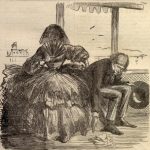 capturing the crew, Hollins took control of the ship. At this point, the purpose of their mission began. They had planned to capture a Union gunboat, the Pawnee, but it was called away. Instead, the Saint Nicholas and its pirate crew came upon a ship loaded with Brazilian coffee, and two more ships, carrying loads of ice and coal. Both ships quickly fell to the Saint Nicholas. For his actions, Hollins received a promotion to commodore and was sent to New Orleans to command the naval forces there at the end of July. On July 8, he would try another daring mission, to capture the Columbia, a sister ship of the Saint Nicholas, but the captain of the Saint Nicholas was on board the Columbia, on his way home after being released by the Confederate authorities. He recognized the men and they were arrested. It was the end of his tirade.
capturing the crew, Hollins took control of the ship. At this point, the purpose of their mission began. They had planned to capture a Union gunboat, the Pawnee, but it was called away. Instead, the Saint Nicholas and its pirate crew came upon a ship loaded with Brazilian coffee, and two more ships, carrying loads of ice and coal. Both ships quickly fell to the Saint Nicholas. For his actions, Hollins received a promotion to commodore and was sent to New Orleans to command the naval forces there at the end of July. On July 8, he would try another daring mission, to capture the Columbia, a sister ship of the Saint Nicholas, but the captain of the Saint Nicholas was on board the Columbia, on his way home after being released by the Confederate authorities. He recognized the men and they were arrested. It was the end of his tirade.
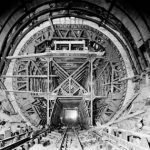 Most safety measures have come from disasters caused by a lack of safety measures. The Hawk’s Nest Tunnel disaster was no different. But sometimes, the safety measures were known and readily available, but were not used, often to save time or money, and always in blatant disregard for the lives of the workers. On March 30, 1930, construction began on the Hawk’s Nest Tunnel. The tunnel was supposed to be a good thing, and in the end, it was, but the necessary measures were not used to keep the workers safe, and the time they spent in the tunnel turned out to be deadly.
Most safety measures have come from disasters caused by a lack of safety measures. The Hawk’s Nest Tunnel disaster was no different. But sometimes, the safety measures were known and readily available, but were not used, often to save time or money, and always in blatant disregard for the lives of the workers. On March 30, 1930, construction began on the Hawk’s Nest Tunnel. The tunnel was supposed to be a good thing, and in the end, it was, but the necessary measures were not used to keep the workers safe, and the time they spent in the tunnel turned out to be deadly.
This tunnel would be used to divert much of the flow of the New River from the Hawk’s Nest Dam under Gauley Mountain, located about 3 miles away, to a hydro-electric plant at the other end. As construction proceeded, it was discovered that the rock they were cutting had a high silica content. Silica was used in steel making. It seemed like a win-win situation, but  not for the 3,000 mostly African-American migrant workers from the south. Rhinehart and Dennis, a company from Charlottesville, Virginia, was awarded the contract. While the management, who visited the tunnel periodically, wore masks and breathing equipment, the workers were not given such equipment. Drilling should have been done using water, but it was not. They were trying to save time and money. The workers were exposed to the silica dust and developed a lung disease called silicosis, for which there is no cure.
not for the 3,000 mostly African-American migrant workers from the south. Rhinehart and Dennis, a company from Charlottesville, Virginia, was awarded the contract. While the management, who visited the tunnel periodically, wore masks and breathing equipment, the workers were not given such equipment. Drilling should have been done using water, but it was not. They were trying to save time and money. The workers were exposed to the silica dust and developed a lung disease called silicosis, for which there is no cure.
This deliberate disregard for safety caused some of the workers to become sick and die from silicosis within a year. There were only 109 admitted deaths, but a Congressional hearing conducted later determined that there were actually 476 deaths attributed to the project. Since that time, some sources have said the number could actually be as high as 700 to 1,000 deaths. This takes into account the workers that could have had minimal  exposure to the silica but were affected by it later in life.
exposure to the silica but were affected by it later in life.
The Hawk’s Nest Tunnel is still in use today, diverting water from the New River to produce hydro-electricity for the Alloy plant. Silicosis has been designated an occupational disease. Now compensation for workers affected by it is available. Unfortunately, the tunnel workers at Hawk’s Nest were not protected by these laws. This project is considered to be one of the worst industrial disasters in American history. The tunnel did its job, and continues to do so. I just wish it hadn’t cost so many lives to make the tunnel. It should not have had to come at such a great price.
 When we think of the Old West, the Pioneer movement, the Gold Rush, and generally, the settling of the United States, our minds immediately go to the brave men who fought the Indians, ran the wagon trains, weathered the harsh winters looking for their fortunes, and fought in the wars to make this a free nation, but seldom do we think of the anonymous heroes of that time…the women. There is a saying, “Behind every great man there’s a great woman.” that saying is one reference to the many women who have set aside their own comforts to support their man in the goals and dreams he has. In many ways that saying is the picture of the Pioneer woman, but it actually leaves something out. Just because her man did not become famous, doesn’t mean that the woman was any less behind him, supporting him in all he did.
When we think of the Old West, the Pioneer movement, the Gold Rush, and generally, the settling of the United States, our minds immediately go to the brave men who fought the Indians, ran the wagon trains, weathered the harsh winters looking for their fortunes, and fought in the wars to make this a free nation, but seldom do we think of the anonymous heroes of that time…the women. There is a saying, “Behind every great man there’s a great woman.” that saying is one reference to the many women who have set aside their own comforts to support their man in the goals and dreams he has. In many ways that saying is the picture of the Pioneer woman, but it actually leaves something out. Just because her man did not become famous, doesn’t mean that the woman was any less behind him, supporting him in all he did.
Pioneer women were there, on the home front, working hard all day trying to keep their house clean in a rugged windswept frontier. Her floors were often made of dirt, and yet she swept them. The water came from a well, or a nearby creek, and she had to haul it into the house, because her man was off hunting to bring in food for the family. The house was crudely constructed with logs and often had a sod roof, and she was right there working like a man beside her husband to get that house built. She watched over the children, and kept them safe from the many perils that were a daily encounter. From snakes, to bears, to mountain lions, to Indians, she did what she needed to, even to the point of handling a gun as well as her husband did. And yet, history looked at her as the weaker part of the partnership, the one who needed to be sheltered and protected. History looked at her as if she could not 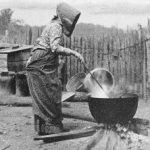 even bear to hear about certain things, because they might be too upsetting to her. In reality, they had vastly underestimated their women.
even bear to hear about certain things, because they might be too upsetting to her. In reality, they had vastly underestimated their women.
When the men got hurt, and the garden needed to be cared for, the women would till the ground…fighting with the tiller behind a horse, and winning the battle. These women took care of the house, the children, the sick or injured husband, and the garden or other crops, all without batting an eye. These women knew all about the hardships of frontier living, and when the going got tough, they didn’t turn and run back east. When the Indians attacked, they stayed and fought with their men. They could not afford to hide in a cellar, their hands were needed to hold a gun. They even faced the Indians alone, when their men were away, becoming excellent negotiators, who were able to make a trade of their wares that, in the end saved their own lives and the lives of their families. They were determined to make this new frontier work, and for the most part, they did it all without making a name for themselves. Sometimes, when we look up ancestors in historic archives, these women are either listed only as Mrs, acknowledging only the husband’s name, or they were listed only as the wife of their husband. Their true identity sometimes remains forever a mystery, and yet, they were heroes…but, they were anonymous heroes. The great men they stood behind, thereby making these men successful, may have been heroes of the frontier, and their name may have been one that every history book told us all about, 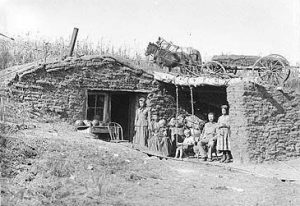 but their wives, who worked quietly beside them, remained unknown. We knew about the exploits of the men, the towns they founded, the travels they made exploring ever westward, but the women who were there with them, cooking the meals while the men talked, cleaning up afterward alone, delivering their babies often with only the help of their husband, carrying a baby, while weeding a garden, and feeding their family before themselves, going hungry, if necessary, to make sure the family was taken care of…these women rarely made the history books. Their job must have seemed to mundane to be considered adventurous, but without their contribution, this nation would not have become the great Republic that it is.
but their wives, who worked quietly beside them, remained unknown. We knew about the exploits of the men, the towns they founded, the travels they made exploring ever westward, but the women who were there with them, cooking the meals while the men talked, cleaning up afterward alone, delivering their babies often with only the help of their husband, carrying a baby, while weeding a garden, and feeding their family before themselves, going hungry, if necessary, to make sure the family was taken care of…these women rarely made the history books. Their job must have seemed to mundane to be considered adventurous, but without their contribution, this nation would not have become the great Republic that it is.
 Tornado warnings and warning sirens are things that just about every person knows about these days, but in 1944, they weren’t available at all. It wasn’t that no one had thought about a tornado warning system, but rather that they had and they decided against it,and so nothing was developed. If you’re like me, you wonder why anyone would think it a bad idea to warn people about the possibility of a tornado, but that was exactly what happened. According to a report titled “The History (and Future) of Tornado Warning Dissemination in the United States” by Timothy A. Coleman, Kevin R. Knupp, James Spann, J. B. Elliott, and Brian E. Peters, “Despite promising research on the conditions that are favorable for tornadoes in the 1880s by John P. Finley, a general consensus was reached among scientists in the 1880s and 1890s that tornado forecasts and warnings would cause more harm than good. A ban was placed on the issuance of tornado warnings from 1887, when the U.S. Army Signal Corps handled weather forecasts, until 1938, when the civilian U.S. Weather Bureau (USWB) finally lifted the ban.” Even after the an was lifted, warnings were pretty primitive. Modern tornado warning really took off and began to develop in 1948…too late for the people of West Virginia and Pennsylvania on June 23, 1944.
Tornado warnings and warning sirens are things that just about every person knows about these days, but in 1944, they weren’t available at all. It wasn’t that no one had thought about a tornado warning system, but rather that they had and they decided against it,and so nothing was developed. If you’re like me, you wonder why anyone would think it a bad idea to warn people about the possibility of a tornado, but that was exactly what happened. According to a report titled “The History (and Future) of Tornado Warning Dissemination in the United States” by Timothy A. Coleman, Kevin R. Knupp, James Spann, J. B. Elliott, and Brian E. Peters, “Despite promising research on the conditions that are favorable for tornadoes in the 1880s by John P. Finley, a general consensus was reached among scientists in the 1880s and 1890s that tornado forecasts and warnings would cause more harm than good. A ban was placed on the issuance of tornado warnings from 1887, when the U.S. Army Signal Corps handled weather forecasts, until 1938, when the civilian U.S. Weather Bureau (USWB) finally lifted the ban.” Even after the an was lifted, warnings were pretty primitive. Modern tornado warning really took off and began to develop in 1948…too late for the people of West Virginia and Pennsylvania on June 23, 1944.
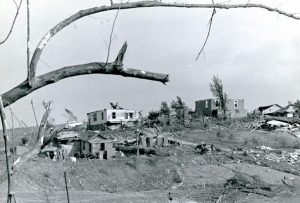
On that June 23rd in 1944, a series of tornadoes across West Virginia and Pennsylvania kill more than 150 people. Most of the twisters were classified as F3, but the most deadly one was an F4 on the Fujita scale, meaning it was a devastating tornado, with winds in excess of 207 miles per hour. The afternoon was very hot, when atmospheric conditions suddenly changed and the tornadoes began to form in Maryland. At about 5:30 pm, an F3 tornado, with winds between 158 and 206 miles per hour, struck in western Pennsylvania. That storm killed two people. Just Forty-five minutes later, a very large twister began in West Virginia, and moved into Pennsylvania. It then tracked back to West Virginia. By the time this F4 tornado ended, it had killed 151 people and leveled hundreds of homes. Another tornado struck that afternoon at a YMCA camp in Washington, Pennsylvania. A letter written by a camper was later found 100 miles away. Area Coal-mining towns were also hit hard on June 23rd. There were some reports that a couple of tornadoes actually crossed the Appalachian mountain range, going up one side and coming down the other…a very rare event with any mountain. Finally, about 10 pm, the remarkable series of twisters finally ended, after the last one hit in Tucker County, West Virginia. In all, the storms caused the  destruction of thousands of structures and millions of dollars in damages, and that was just the monetary losses.
destruction of thousands of structures and millions of dollars in damages, and that was just the monetary losses.
While there isn’t much that can be done to spare property in the path of tornadoes, an early warning, and the appropriate action taken, can save the lives of hundreds of people. Sadly, early warnings were not available to save the 153 people killed in the tornado outbreak of June 23, 1944. They were still in the works, because of all the years wasted when scientists decided it was not in the public’s best interest to know about tornadoes. I’m really thankful that the ban was lifted and we have these necessary warnings these days.
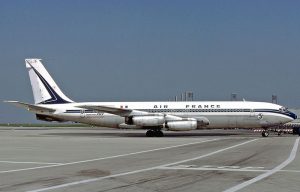 On June 22, 1962, an Air France Boeing 707 crashed on the island of Guadeloupe, killing all 113 passengers and crew members aboard. It was one of five major accidents involving Boeing 707s during that year. In all, the five crashes that year killed 457 people. Crashes happen, and unfortunately, they are not always such an unusual occurrence. Nevertheless, there was a mystery involved here. The Boeing 707 was originally a KC-135 military tanker and bomber. Boeing later decided to modify it to be used for civilian transport, and the finished product was the Boeing 707. The new design proved very popular in the commercial aviation industry. The Boeing 707 was not a fuel efficient as some of the other planes of that era, but it was faster than any other commercial jet at that time, so it made up for the fuel problem with its greater speed.
On June 22, 1962, an Air France Boeing 707 crashed on the island of Guadeloupe, killing all 113 passengers and crew members aboard. It was one of five major accidents involving Boeing 707s during that year. In all, the five crashes that year killed 457 people. Crashes happen, and unfortunately, they are not always such an unusual occurrence. Nevertheless, there was a mystery involved here. The Boeing 707 was originally a KC-135 military tanker and bomber. Boeing later decided to modify it to be used for civilian transport, and the finished product was the Boeing 707. The new design proved very popular in the commercial aviation industry. The Boeing 707 was not a fuel efficient as some of the other planes of that era, but it was faster than any other commercial jet at that time, so it made up for the fuel problem with its greater speed.
The airport on the island of Guadeloupe is located in a valley that is surrounded by mountains. Guadeloupe is a part of the French West Indies,located in the Caribbean. This particular airport is not the pilots favorite, because it requires them to make a steep descent just prior to landing. Any problem that occurs in the descent, is very hard to correct, because there is just no time. On June 22, the Air France flight failed to descend correctly and crashed directly into a peak call Dos D’Ane, or the Donkey’s Back. The plane exploded in a fireball; there were no survivors. The flight occurred before the black box flight recorder was invented, so no sure reason for the crash was ever officially found.
This crash was the third deadly crash of a Boeing 707 in a month, so something had to be done. On May 22nd, 45 people died when a plane went down in Missouri and on June 3rd, another Air France 707 crashed in Paris killing 130 people. No evidence was ever found that connected the accidents. It is believed that the weather played a part in the June 22, 1962 crash. The weather was poor in Guadeloupe that day. A violent thunderstorm was in the area, with a low cloud ceiling. Adding to the problem, the VOR navigational beacon 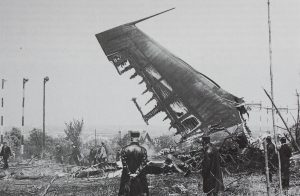 was out of service. The crew reported themselves over the non-directional beacon (NDB) at 5,000 feet and turned east to begin the final approach. That was the last time that anything was “normal” with the flight. Due to incorrect automatic direction finder (ADF) readings caused by the thunderstorm, the plane strayed 9.3 mile west from the procedural let-down track. Moments later, the plane crashed in a forest on the hill called Dos D’Ane, at about 1,400 feet and then exploded. There were no survivors. Among the dead was French Guianan politician and war hero Justin Catayée and poet and black-consciousness activist Paul Niger. While weather played a significant part in the crash, it was not the only cause.
was out of service. The crew reported themselves over the non-directional beacon (NDB) at 5,000 feet and turned east to begin the final approach. That was the last time that anything was “normal” with the flight. Due to incorrect automatic direction finder (ADF) readings caused by the thunderstorm, the plane strayed 9.3 mile west from the procedural let-down track. Moments later, the plane crashed in a forest on the hill called Dos D’Ane, at about 1,400 feet and then exploded. There were no survivors. Among the dead was French Guianan politician and war hero Justin Catayée and poet and black-consciousness activist Paul Niger. While weather played a significant part in the crash, it was not the only cause.
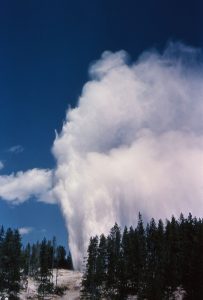 These days, at least in Wyoming, the news is often full of new eruption stories pertaining to Steamboat Geyser in Yellowstone National Park. Steamboat Geyser was dormant from 1911 to 1961. Eleven eruptions were noted between June 4, 1990 and September 23, 2014. Then beginning on March 15, 2018, we have seen a sudden increase in eruptions. Beginning on March 15th, there have been ten eruptions to date…just over three months. That is unheard of for this geyser in recorded history. In reality, it can do what Kilauea has done on Hawaii’s Big Island, only much bigger, because the geyser field in Yellowstone National Park lies on top of an active volcano, with multiple chambers of magma from deep beneath the earth. The same energy that causes geysers to blow could spew an ash cloud as far as Chicago and Los Angeles.
These days, at least in Wyoming, the news is often full of new eruption stories pertaining to Steamboat Geyser in Yellowstone National Park. Steamboat Geyser was dormant from 1911 to 1961. Eleven eruptions were noted between June 4, 1990 and September 23, 2014. Then beginning on March 15, 2018, we have seen a sudden increase in eruptions. Beginning on March 15th, there have been ten eruptions to date…just over three months. That is unheard of for this geyser in recorded history. In reality, it can do what Kilauea has done on Hawaii’s Big Island, only much bigger, because the geyser field in Yellowstone National Park lies on top of an active volcano, with multiple chambers of magma from deep beneath the earth. The same energy that causes geysers to blow could spew an ash cloud as far as Chicago and Los Angeles.
It’s strange to think about the fact that Yellowstone National Park lies on such a huge volcano, and yet three extremely large explosive eruptions have occurred at Yellowstone in the past 2.1 million years with a recurrence 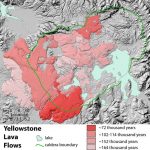 interval of about 600,000 to 800,000 years. More frequent eruptions of basalt and rhyolite lava flows have occurred before and after the large caldera-forming events. It is said that if the Yellowstone volcano erupted again, it it would be catastrophic, but with the chances of a supervolcanic paroxysm being currently around one-in-730,000, it is less likely than a catastrophic asteroid impact. I guess Wyomingites can breathe a little easier. Nevertheless, scientists do want to know what’s behind the most recent activity at Steamboat Geyser. “We see gas emissions. We see all kinds of thermal activity. That’s what Yellowstone does. That’s what it’s supposed to do. It’s one of the most dynamic places on earth,” said Mike Poland, the scientist in charge of the Yellowstone Volcano Observatory.
interval of about 600,000 to 800,000 years. More frequent eruptions of basalt and rhyolite lava flows have occurred before and after the large caldera-forming events. It is said that if the Yellowstone volcano erupted again, it it would be catastrophic, but with the chances of a supervolcanic paroxysm being currently around one-in-730,000, it is less likely than a catastrophic asteroid impact. I guess Wyomingites can breathe a little easier. Nevertheless, scientists do want to know what’s behind the most recent activity at Steamboat Geyser. “We see gas emissions. We see all kinds of thermal activity. That’s what Yellowstone does. That’s what it’s supposed to do. It’s one of the most dynamic places on earth,” said Mike Poland, the scientist in charge of the Yellowstone Volcano Observatory.
Steamboat Geyser is the least predictable geyser in all of Yellowstone National Park. It could erupt in five 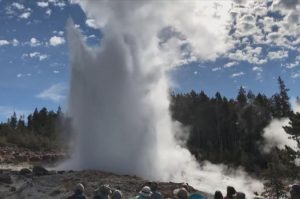 minutes, five years, or even 50 years from now. Yet no one visiting Yellowstone wants to turn away from the sight. “That would be the chance of a lifetime,” one visitor said. “I would be amazed.” Steamboat Geyser,is the world’s tallest and far more powerful than Old Faithful, and right now, it’s roaring back to life. Still, timing is everything, and only a few people get to see it. Poland’s team of volcanologists are using thermal-imaging equipment to track the temperature of the 50-mile-wide magma field. They also monitor 28 seismographs since a super volcano would include major earthquake activity. So far,there is no indication that this is anything other than an unusual series of eruptions, and not indication of increased volcanic activity, which puts many people’s minds at ease. The geyser is welcome to continue erupting, but I say, “Just leave that volcano alone.”
minutes, five years, or even 50 years from now. Yet no one visiting Yellowstone wants to turn away from the sight. “That would be the chance of a lifetime,” one visitor said. “I would be amazed.” Steamboat Geyser,is the world’s tallest and far more powerful than Old Faithful, and right now, it’s roaring back to life. Still, timing is everything, and only a few people get to see it. Poland’s team of volcanologists are using thermal-imaging equipment to track the temperature of the 50-mile-wide magma field. They also monitor 28 seismographs since a super volcano would include major earthquake activity. So far,there is no indication that this is anything other than an unusual series of eruptions, and not indication of increased volcanic activity, which puts many people’s minds at ease. The geyser is welcome to continue erupting, but I say, “Just leave that volcano alone.”
 When we think of deployment, we think of the military and of war, but there are other ways to be deployed too, and some of them do not even include the military. Every year, thousands of firefighters are separated from their family members, some of them for months at a time. For the most part, these are wildland firefighters, but sometimes they even have to enlist the help of teams from cities around the country. Wildland fires are not bound by the schedules of humans. Once they get going, they take on a life of their own. Firefighters are in it for the long haul, and many wildland firefighters go from fire to fire, spending the entire fire season far away from their families.
When we think of deployment, we think of the military and of war, but there are other ways to be deployed too, and some of them do not even include the military. Every year, thousands of firefighters are separated from their family members, some of them for months at a time. For the most part, these are wildland firefighters, but sometimes they even have to enlist the help of teams from cities around the country. Wildland fires are not bound by the schedules of humans. Once they get going, they take on a life of their own. Firefighters are in it for the long haul, and many wildland firefighters go from fire to fire, spending the entire fire season far away from their families.
The other night my husband, Bob and I were watching a television program called FireStorm. The show focused on not just what happens during a wildfire, but also on the people who are affected by the fire, that most of us never think about…the firefighters. These are the people who leave their families at home and head out to fight a fire at a moments notice. Some of these people are gone for as much as nine months out of the year, going from fire to fire. These people include the smoke jumpers, the tanker 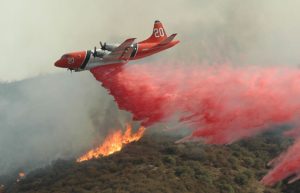 plane personnel, the hotshot units, and sometimes teams from cities in the area, as well as the Bureau of Land Management, and the Forest Service firefighting teams. These people talked about missing everything from school functions to weddings and childbirth. The fires wait for no man, and people depend on these men and women to drop everything and come quickly to try to save their homes.
plane personnel, the hotshot units, and sometimes teams from cities in the area, as well as the Bureau of Land Management, and the Forest Service firefighting teams. These people talked about missing everything from school functions to weddings and childbirth. The fires wait for no man, and people depend on these men and women to drop everything and come quickly to try to save their homes.
Smoke jumpers are especially isolated. They jump into a fire area and they are pretty much on their own for up to 3 weeks. The have to pack supplies, tents, and water with them. Part of it is dropped with the smoke jumpers and part of it with it’s own parachute. These firefighters are on their own now…in the middle of the monster. Obviously, they have ways out, but often it is by helicopter. They have to be alert at all times, and there is no time for fun and games. Smoke jumpers are essentially seal teams, when compared to the military. They go out on missions that no one else wants to attempt, and most often, they come back alive too. That is not always the case of course, because some of these teams have been overtaken and killed like the Prineville,  Oregon hotshot team killed on Storm King Mountain in Colorado, when the fire exploded and ran up the hill overtaking them. They paid the ultimate sacrifice for other people in an effort to save lives and homes.
Oregon hotshot team killed on Storm King Mountain in Colorado, when the fire exploded and ran up the hill overtaking them. They paid the ultimate sacrifice for other people in an effort to save lives and homes.
Firefighters who go out for months at a time fighting wildfires all over the country, are truly just as much deployed as their military counterparts, but we seldom think about the family side of their time fighting the fires. The spouses and children, and even parents and siblings, waiting and praying that their firefighter will make it home. It is a different kind of deployment, but it is a deployment nevertheless.
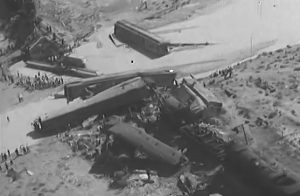 A sudden downpour near Terry, Montana on the evening of June 19, 1938 caused a flash flooding of the Custer Creek that would lead to a disaster before the night was over. Earlier in the day, a track walker was sent out the check the rail lines near Custer Creek which was located near the town of Terry, Montana. After his inspection, he reported to his superiors that the conditions were dry, and there were no problems with the tracks.
A sudden downpour near Terry, Montana on the evening of June 19, 1938 caused a flash flooding of the Custer Creek that would lead to a disaster before the night was over. Earlier in the day, a track walker was sent out the check the rail lines near Custer Creek which was located near the town of Terry, Montana. After his inspection, he reported to his superiors that the conditions were dry, and there were no problems with the tracks.
That was true at the time, but within a few hours, a sudden downpour overwhelmed Custer Creek. A small winding river, Custer Creek runs through 25 miles of the Great Plains before depositing into the Yellowstone River. Small streams like Custer Creek are prone to flash floods, because they don’t have  the capacity to handle any big influx of water, and their banks can quickly and easily be overtaken during heavy rains. As the water came rushing down stream, it washed out a bridge used by the trains. When the Olympian Special came through, it went crashing into the raging waters with no warning. Two sleeper cars were buried in the muddy waters. The night was pitch black seriously hampering rescue efforts. In all, 46 people lost their lives, and 60 others were seriously injured. The rear cars stayed above the water, but scores of passengers were seriously injured. They could not be evacuated until the following morning. I can’t even begin to imagine how awful that was.
the capacity to handle any big influx of water, and their banks can quickly and easily be overtaken during heavy rains. As the water came rushing down stream, it washed out a bridge used by the trains. When the Olympian Special came through, it went crashing into the raging waters with no warning. Two sleeper cars were buried in the muddy waters. The night was pitch black seriously hampering rescue efforts. In all, 46 people lost their lives, and 60 others were seriously injured. The rear cars stayed above the water, but scores of passengers were seriously injured. They could not be evacuated until the following morning. I can’t even begin to imagine how awful that was.
That was a tough week for Montana. Just a few days later, Black Eagle saw “torrents of water” that floated 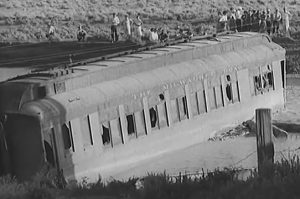 furniture in the house of Sam Tadich, the sheriff had to help a rescue effort, the road to Giant Springs washed away and water was up to cows’ flanks around the Sun River. Havre’s worst flood came in June 22, 1938, when a cloudburst in the Bear Paw Mountains sent out a wall of water. Ten people were killed. Floating train cars were wedged under the viaduct, 10 miles of highway were underwater between Laredo and Box Elder, with a bridge washed out, the Havre Daily News reported. Rain is a good thing, but too much rain, coming too fast can devastate an area, especially one with a creek or river, in a very short time, and for Montana, it was a very rainy week, making it a very tough week.
furniture in the house of Sam Tadich, the sheriff had to help a rescue effort, the road to Giant Springs washed away and water was up to cows’ flanks around the Sun River. Havre’s worst flood came in June 22, 1938, when a cloudburst in the Bear Paw Mountains sent out a wall of water. Ten people were killed. Floating train cars were wedged under the viaduct, 10 miles of highway were underwater between Laredo and Box Elder, with a bridge washed out, the Havre Daily News reported. Rain is a good thing, but too much rain, coming too fast can devastate an area, especially one with a creek or river, in a very short time, and for Montana, it was a very rainy week, making it a very tough week.
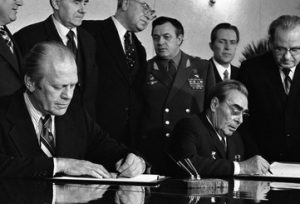 During the Cold War, the threat of a nuclear attack was the biggest concern in world relationships. During the late 1960s, the United States learned that the Soviet Union had embarked upon a massive Intercontinental Ballistic Missile (ICBM) buildup designed to catch up with the United States. The situation seemed to be heating up, because the Soviet Union seemed far more likely to use such weapons, so it looked like it was time to take action. In January 1967, President Lyndon Johnson announced that the Soviet Union had begun to construct a limited Anti-Ballistic Missile (ABM) defense system around Moscow. The development of an ABM system could allow one side to launch a first strike and then prevent the other from retaliating by shooting down incoming missiles. That was completely unacceptable.
During the Cold War, the threat of a nuclear attack was the biggest concern in world relationships. During the late 1960s, the United States learned that the Soviet Union had embarked upon a massive Intercontinental Ballistic Missile (ICBM) buildup designed to catch up with the United States. The situation seemed to be heating up, because the Soviet Union seemed far more likely to use such weapons, so it looked like it was time to take action. In January 1967, President Lyndon Johnson announced that the Soviet Union had begun to construct a limited Anti-Ballistic Missile (ABM) defense system around Moscow. The development of an ABM system could allow one side to launch a first strike and then prevent the other from retaliating by shooting down incoming missiles. That was completely unacceptable.
President Johnson decided to call for strategic arms limitations talks…nicknamed SALT, and in 1967, he and Soviet Premier Alexei Kosygin met at Glassboro State College in New Jersey. Johnson said they must gain “control of the ABM race,” and Secretary of Defense Robert McNamara argued that the more each reacted to the other’s escalation, the more they had chosen “an insane road to follow.” Completely abolishing nuclear weapons would be impossible, but limiting the development of both offensive and defensive strategic systems could be done, and it might help stabilize relations between the 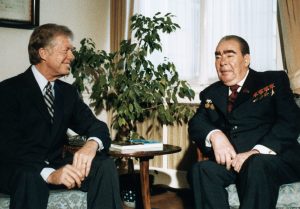 United States and the Soviet Union. The resulting SALT-I treaty was signed in 1972. The 1972 treaty limited a wide variety of nuclear weapons, but it did not address many of the other issues, so shortly after the SALT-I treaty was ratified, talks between the United States and the Soviet Union began anew. Those talks failed to achieve any new breakthroughs. By 1979, both the United States and the Soviet Union were eager to try again. For the United States, the thought that the Soviets were leaping ahead in the arms race was the primary motivator. For the Soviet Union, the increasingly close relationship between America and communist China was a cause for growing concern.
United States and the Soviet Union. The resulting SALT-I treaty was signed in 1972. The 1972 treaty limited a wide variety of nuclear weapons, but it did not address many of the other issues, so shortly after the SALT-I treaty was ratified, talks between the United States and the Soviet Union began anew. Those talks failed to achieve any new breakthroughs. By 1979, both the United States and the Soviet Union were eager to try again. For the United States, the thought that the Soviets were leaping ahead in the arms race was the primary motivator. For the Soviet Union, the increasingly close relationship between America and communist China was a cause for growing concern.
The SALT-II agreement was the result of those many nagging issues that were left over from the successful SALT-I treaty of 1972, but it had problems of its own. The treaty basically established numerical equality between the two nations in terms of nuclear weapons delivery systems. It also limited the number of MIRV missiles (missiles with multiple, independent nuclear warheads). In truth, the treaty did little or nothing to stop, or even substantially slow down, the arms race, and it met with unrelenting criticism in the United States. The treaty was thought to be a “sellout” to the Soviets. People believed that it would leave America virtually defenseless against a whole range of new weapons not mentioned in the agreement. Even supporters of arms control were less than enthusiastic about the treaty, since it did little to actually control arms. Nevertheless, during a summit meeting in Vienna, President Jimmy Carter and Soviet leader Leonid Brezhnev signed the 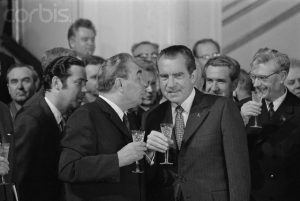 SALT-II agreement dealing with limitations and guidelines for nuclear weapons, on June 18, 1979. The treaty, would never formally go into effect, and it proved to be one of the most controversial agreements between the United States and the Soviet Union of the entire Cold War. Debate over SALT-II in the U.S. Congress continued for months. Then in December 1979, the Soviets invaded Afghanistan. The Soviet attack effectively killed any chance of SALT-II being passed, and Carter ensured this by withdrawing the treaty from the Senate in January 1980. SALT-II thus remained signed, but was never ratified. During the 1980s, both nations agreed to respect the agreement until such time as new arms negotiations could take place.
SALT-II agreement dealing with limitations and guidelines for nuclear weapons, on June 18, 1979. The treaty, would never formally go into effect, and it proved to be one of the most controversial agreements between the United States and the Soviet Union of the entire Cold War. Debate over SALT-II in the U.S. Congress continued for months. Then in December 1979, the Soviets invaded Afghanistan. The Soviet attack effectively killed any chance of SALT-II being passed, and Carter ensured this by withdrawing the treaty from the Senate in January 1980. SALT-II thus remained signed, but was never ratified. During the 1980s, both nations agreed to respect the agreement until such time as new arms negotiations could take place.

